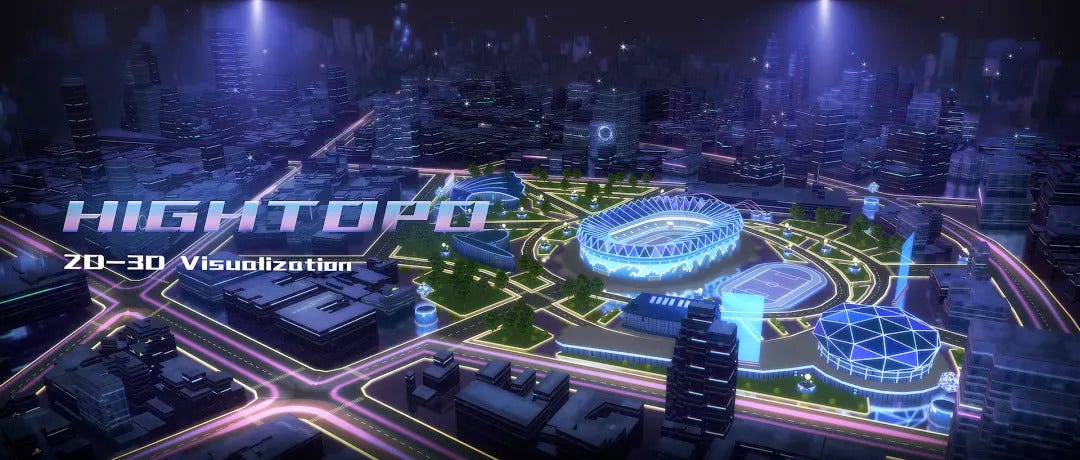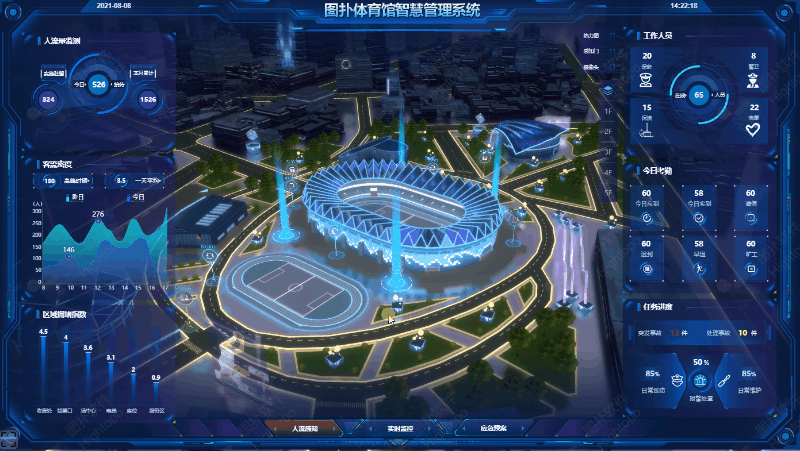Hightopo 3D Meets Gaussian Splashes: A New Era in Data Visualization
3D Gaussian Splatting (also known as 3D Gaussian Splashing or 3D Gaussian Spray) represents a significant breakthrough in 3D scene representation and rendering. It utilizes deep learning technology, using 3D Gaussian points instead of traditional triangle meshes to express scenes. This approach facilitates both efficient 3D transformation and produces exceptional photorealistic rendering results. In comparison to conventional methodologies, this technology has significant improvements across key performance metrics, including rendering quality, rendering speed, and training speed.
In this article, we will introduce the visualization project built using 3D Gaussian Splatting technology for Hightopo Software’s Xiamen office and Zhongshan Road Pedestrian Street. By completely mapping every building, detail, light and shadow from the real scene into the virtual space, users can enjoy the architectural environment from all angles in the virtual space and obtain an immersive spatial interactive experience.
About 3D Gaussian Splatting The basic workflow of 3D Gaussian Splatting can be divided into three main stages:
- Data Acquisition Stage
• For small scenes: Simple video capture using a smartphone is sufficient
• For large scenes: Professional equipment is used to ensure high precision and clarity, typically completed within 30 minutes
- Model Training Stage
• Utilizes GPU computing power to process and train the model data
• Training duration depends on GPU capabilities, usually taking about one day
• Involves processing captured images to generate 3D Gaussian points with position, scale, rotation, and appearance attributes
- Rendering and Deployment Stage
Implementation of real-time rendering using Hightopo graphics engines
Technical Advantages and Limitations ■ Key Advantages
High-Quality Rendering: 3D Gaussian Splatting can generate highly realistic 3D scenes with excellent detail and texture representation. Efficient Modeling: Compared to traditional methods and other techniques like NeRF, training with 3D Gaussian Splatting converges faster, allowing complex scene modeling in less time. Strong Adaptability: This technique can handle a wide range of scenarios, from microscopic objects to macro environments. Real-time Performance: 3D Gaussian Splatting provides fast rendering and real-time interaction, offering a smooth user experience. Flexible Data Processing: The method can process multiple data inputs, including images, videos, and point clouds. ■ Limitations
High Storage Requirements: Large-scale point cloud data processing and storage demand significant disk space, affecting web page loading speed. Compatibility Issues: Integrating 3D Gaussian Splatting models with traditional triangle-based mesh models presents challenges. Hardware Requirements: Performing large-scale scene rendering requires high-performance hardware and GPUs. 3D Gaussian Splatting Scene of Hightopo Office Using 3D Gaussian Splatting technology combined with the Hightopo graphics engine, we have achieved precise reconstruction of the office’s interior space. Beyond perfectly capturing the geometric structure of the space, it excellently renders material textures and lighting effects. The surface materials of walls, floors, furniture, and LED lighting fixtures have been meticulously modeled, creating a scene experience that rivals video-like realism.
This demonstration showcases our office environment through an immersive third-person perspective, utilizing advanced PBR (Physically Based Rendering) material technology to deliver sophisticated character visualization.
3D Navigation Within our advanced 3D office environment, users navigate the workspace through an interactive virtual avatar. Upon approaching designated workstations, the system renders a detailed 3D representation of the corresponding employee and their current status. A professional interface displays pertinent organizational information, including departmental affiliations and role specifications. This sophisticated interactive framework facilitates comprehensive visualization of workplace dynamics and personnel distribution, optimizing both operational efficiency and user engagement in information acquisition.
Point Cloud Mode This 3D scene also supports point cloud mode, which clearly displays the spatial layout and details.
Each office area, meeting room, and facility is precisely represented by dense point clusters, fully recreating the geometric structure, furniture layout, and spatial characteristics of the office environment.
Point clouds have extensive applications, playing crucial roles in urban planning, architectural surveying, human-computer interaction, autonomous driving and other fields, providing a reliable data foundation for spatial analysis and scene understanding.
Outdoor 3D Gaussian Splatting Scene In this scene, we collected 3D data of Xiamen’s Zhongshan Road pedestrian street using point cloud technology and transformed it into Gaussian points, precisely capturing the geometric shapes and material details of the buildings. After professional processing, these Gaussian points form continuous smooth surface effects, perfectly reproducing the architectural features. Whether it’s buildings, road vegetation, street lights, or vehicles, all scene elements are accurately recreated at a 1:1 scale.
Virtual Street Tour In this high-quality 3D visualization scene, the unique Southern Fujian architectural charm of Zhongshan Road is fully preserved, with clear presentation of everything from the green glazed tile gate tower roofs to the Chinese cloud pattern decorations on the door pillars. Users can freely stroll in this virtual environment, experiencing an immersive journey through the distinctive Southeast Asian style and Southern Fujian traditional architectural charm of Zhongshan Road’s arcade buildings.
Multi-Device Interaction In terms of system functionality and accessibility, Hightopo Graphics Engine’s underlying technology ensures perfect operation of the system across multiple devices.
Users can operate through various terminal devices including PC, mobile phones, tablets, large screens, and VR/AR devices. It supports keyboard control using WASD or arrow keys, and for touch screen devices, it offers functions like single-finger rotation, two-finger zooming, and three-finger panning.
Summary In recent years, 3D Gaussian Splatting technology has shown tremendous application potential in virtual tours, digital cultural tourism, emergency rescue, and other fields of scene reconstruction, providing unlimited possibilities for virtual reality and metaverse industries.
As a pioneer in HTML5 (Canvas/WebGL/WebGPU/WebXR) Web technology innovation, Hightopo Software will continue to deepen industry development, delivering stunning large-scale scenes to clients through more refined, realistic, and efficient 3D rendering technology, driving digital transformation across industries to new heights.







